How a Queen Who Wore Black Gave Us White Wedding Gowns
With June in full swing, you may find yourself in a church pew watching a lovely woman make her way down the aisle. Maybe a little girl will lean over and whisper that timeless ditty, “Here comes the bride, all dressed in white ….”
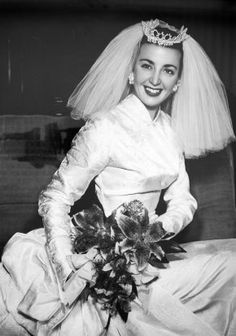 Believe it or not, if earlier customs were still followed today, she might wear a wedding dress of royal purple. Or midnight blue. Or bright crimson. (Though somehow, Billy Idol singing “It’s a nice day for a red wedding” wouldn’t have sounded the same.)
Believe it or not, if earlier customs were still followed today, she might wear a wedding dress of royal purple. Or midnight blue. Or bright crimson. (Though somehow, Billy Idol singing “It’s a nice day for a red wedding” wouldn’t have sounded the same.)
Instead it’s white. Always white. In a time when traditions are dropping like pins falling in a bowling alley, people cling to the white wedding gown.
But did you know a frumpy British queen remembered for dressing in deepest black started it? And that a very practical, secret reason was behind her color selection? It’s true. So get ready to learn the real reason why white became the exclusive bridal gown color.
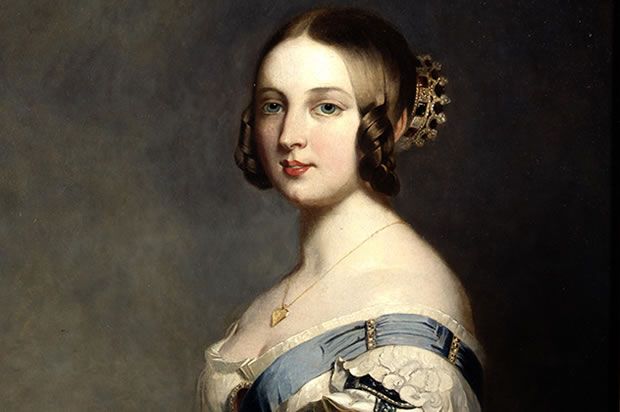 England was gripped with excitement in early 1840. Her Majesty Victoria, by the Grace of God, of the United Kingdom of Great Britain and Ireland, Queen, Defender of the Faith (her official title) was getting married. Think our cousins across the pond were thrilled when William and Kate or Charles and Diana tied the knot? That was nothing; William and Charles were just princes, after all. This was the first time a sitting English queen had wed in nearly 300 years.
England was gripped with excitement in early 1840. Her Majesty Victoria, by the Grace of God, of the United Kingdom of Great Britain and Ireland, Queen, Defender of the Faith (her official title) was getting married. Think our cousins across the pond were thrilled when William and Kate or Charles and Diana tied the knot? That was nothing; William and Charles were just princes, after all. This was the first time a sitting English queen had wed in nearly 300 years.
The 20 year-old Victoria was deliriously happy. She was passionately in love with her fiance (and cousin), Prince Albert of Saxe-Coburg and Gotha. When she proposed to him (as royal protocol dictated, and in German, because Albert spoke very little English), royal wedding planners rolled into action.
Then as now, one question dominated conversations: what would she wear?
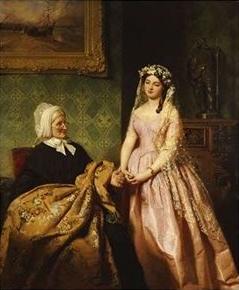 Up till then, brides wore a rainbow of colors on their wedding day. Their gowns were elaborate, sometimes even stitched with threads of silver and gold. Royal brides sometimes walked down the aisle in thick, bright red dresses accompanied by rich furs, crowns and jewels.
Up till then, brides wore a rainbow of colors on their wedding day. Their gowns were elaborate, sometimes even stitched with threads of silver and gold. Royal brides sometimes walked down the aisle in thick, bright red dresses accompanied by rich furs, crowns and jewels.
But Victoria wasn’t buying it. A willful and headstrong child, she became a willful and headstrong monarch as well. This was, after all, the queen who popularized the Christmas tree, established the custom of afternoon tea time and launched Royal Jubilees to celebrate her years on the throne. If Victoria wanted to do something, she did it. And in 1840, she wanted a different type of wedding dress.
Forget the royal robes, she said. I’m making my wedding vows as a woman, not a queen. There would be none of the traditional gaudiness, not even a crown or tiara. She would appear, she said simply as a woman pledging herself to the man she loved.
Bride or not, the Queen of England is still the head of state. And her royal advisers realized the wedding presented a PR bonanza.
 Britain was in the midst of the Industrial Revolution just then, and the introduction of machines was sending its textiles sector topsy-turvy. Machine laces were crippling sales of traditional hand-made laces, putting thousands of skilled artisans out of work. Her Majesty’s wedding gown was an ideal way to showcase this traditional British craft. Victoria agreed, and a large hunk of handmade Honiton lace was purchased.
Britain was in the midst of the Industrial Revolution just then, and the introduction of machines was sending its textiles sector topsy-turvy. Machine laces were crippling sales of traditional hand-made laces, putting thousands of skilled artisans out of work. Her Majesty’s wedding gown was an ideal way to showcase this traditional British craft. Victoria agreed, and a large hunk of handmade Honiton lace was purchased.
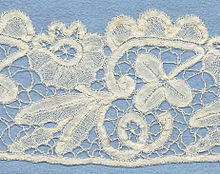 And what better way to show off the lace, her dress designer said, than on white satin. Again, Victoria loved it. But there was another practical (and secret) consideration here as well: white was cost-effective. Prince Albert came from a cash-strapped royal family and didn’t bring much financially to the union. The royal court was unsure how crazy taxpaying Britons would be about footing the bill to support a broke royal consort who didn’t even speak their language. So they were cautious. The wedding wasn’t done on the cheap … but money wasn’t splashed around like it was going out of style, either. White satin was a safe bet.
And what better way to show off the lace, her dress designer said, than on white satin. Again, Victoria loved it. But there was another practical (and secret) consideration here as well: white was cost-effective. Prince Albert came from a cash-strapped royal family and didn’t bring much financially to the union. The royal court was unsure how crazy taxpaying Britons would be about footing the bill to support a broke royal consort who didn’t even speak their language. So they were cautious. The wedding wasn’t done on the cheap … but money wasn’t splashed around like it was going out of style, either. White satin was a safe bet.
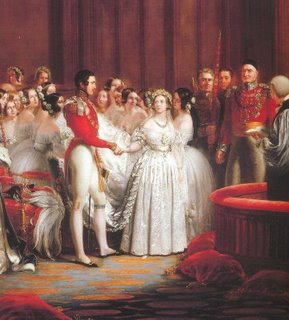 And so when Victoria stood at the altar in London’s St. James Palace on February 10, 1840, her guests couldn’t believe their eyes. Victoria described it this way in her diary: “I wore a satin dress, with deep flounce of Honiton lace. My jewels were my Turkish diamond necklace & earrings & my dear Albert’s beautiful sapphire brooch.” She wore an elaborate veil, also made of the same lace, and orange blossoms (a traditional symbol of fertility) as trim and on top of the veil.
And so when Victoria stood at the altar in London’s St. James Palace on February 10, 1840, her guests couldn’t believe their eyes. Victoria described it this way in her diary: “I wore a satin dress, with deep flounce of Honiton lace. My jewels were my Turkish diamond necklace & earrings & my dear Albert’s beautiful sapphire brooch.” She wore an elaborate veil, also made of the same lace, and orange blossoms (a traditional symbol of fertility) as trim and on top of the veil.
The reaction? There were two sets. Aristocrats (people we would today call the 1 Percent) yawned. They thought the gown utterly lacked style.
But commoners, (everyday folks like you and me) loved it. They saw understated elegance. The fact that their queen wore simple white, an inexpensive color they could afford, signaled it was good enough for them, too. Queen Victoria had, unintentionally and unknowingly, given white her seal of approval. And people instantly embraced it for their own weddings.
So much so that by the 1850s Godey’s Lady’s Book (the era’s final word on women’s fashion in both the U.K. and U.S.) wrote about wedding dresses, “Custom has decided … that white is the most fitting hue, whatever may be the material. It is an emblem of purity and innocence of girlhood, and the unsullied heart she yields to the chosen one.”
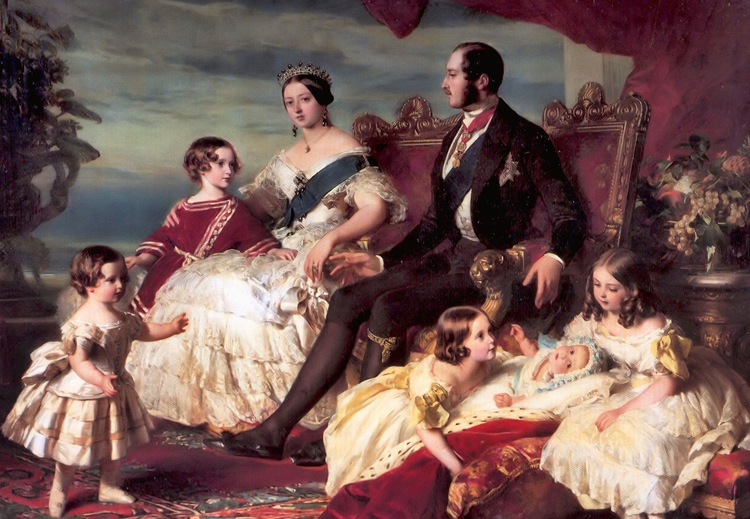 As for Victoria and Albert, theirs was a fabled marriage. They fought like tigers (like many couples, they struggled to devise a power sharing system that worked for them), then passionately made up … with “passionately” being the key word; they wound up having nine-count-’em-nine children. (Apparently, there was a whole lot of making up.)
As for Victoria and Albert, theirs was a fabled marriage. They fought like tigers (like many couples, they struggled to devise a power sharing system that worked for them), then passionately made up … with “passionately” being the key word; they wound up having nine-count-’em-nine children. (Apparently, there was a whole lot of making up.)
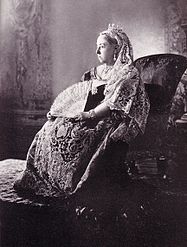 When Albert died of illness at age 42 in December 1861, Victoria was devastated. She never stopped mourning him, and wore nothing but deepest black for the remaining 40 years of her life.
When Albert died of illness at age 42 in December 1861, Victoria was devastated. She never stopped mourning him, and wore nothing but deepest black for the remaining 40 years of her life.
One of her prized possessions was the Honiton lace from her wedding. She wore it in the official portrait taken for her 1897 Diamond Jubilee. When she died in 1901, she was buried with her lace wedding veil from six decades earlier.
And so the tradition of brides in white continues to this day. Forget the myth about “purity and innocence of girlhood” we’ve all heard for years. Wearing white was actually all about propping up a sagging British industry, and saving a few bucks in the royal wedding budget to boot.
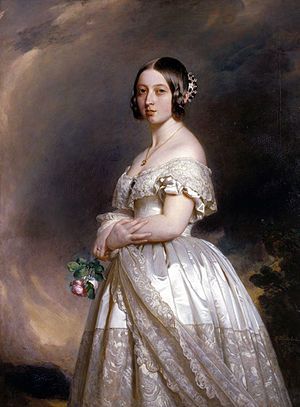 But as they say, “If it ain’t broke, don’t fix it.” White wedding gowns aren’t going anywhere anytime soon.
But as they say, “If it ain’t broke, don’t fix it.” White wedding gowns aren’t going anywhere anytime soon.
Did you find this enjoyable? Please continue to join me each week, and I invite you to read Tell it Like Tupper and share your review!
Curious about Tell It Like Tupper? Here’s a chance to see for yourself. Take a sneak peek at a couple chapters in this free downloadable excerpt.

